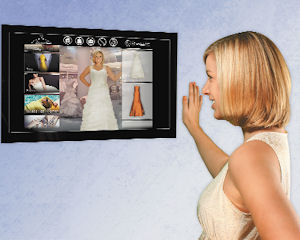Calabasas firm FaceCake Marketing Technologies Inc. is introducing an entirely new dressing room experience with the launch of Swivel, its new 3D virtual dressing room. The program uses motion sensor technology to allow consumers to virtually try on entire outfits without stepping foot into a dressing room or changing out of their clothing. Here’s how it works: A shopper steps in front of a motion control device, or 3D web camera, and the shopper appears as a live image on a television or computer screen, along with item selections from several categories including apparel, shoes and accessories. With a wave of an arm, shoppers can select the item they want to sample and it is digitally overlaid on the person’s body. Swivel also claims to be the first digital dressing room in 3D, allowing shoppers to see themselves from several angles. FaceCake has partnered with Microsoft in integrating Microsoft Kinect’s motion controller with Swivel. Last month, Swivel was showcased in Microsoft’s booth at the National Retail Federation’s Annual Convention and EXPO in New York. For the past year, FaceCake has been participating in trade shows and mall tours to demonstrate, test and promote the technology, said FaceCake’s Founder and CEO Linda Smith. Designed for both an in-store and at-home experience, the technology will be available for retail use by summer and for individual purchase by the end of the year, she said. “We want shoppers to be able to go into a store and use Swivel and then go home and try it on again,” she said. On the retail front, Swivel enables cross-selling through its recommendation engine. The technology also provides retailers metrics on how long an item was tried on, what it was paired with and how many people the shopper showed it to. The digital dressing room concept is not a new one. In the past five years, companies have been creating similar applications that allow consumers to virtually try-on and sample products. And these technologies haven’t been generally accepted by consumers. Last year, Fremont-based ProSent Mobile launched VIZL, an iPhone app that lets shoppers choose in-app apparel and accessories from select retailers. San Francisco online fashion boutique, Fitiquette, also launched a virtual fitting room which allows shoppers to create an online body replica to try on clothing in different sizes. FaceCake’s system allows users to manipulate their own images, with a wide range of image transformation and animation capabilities, to try on and try out various products and services. It allows users to virtually change their hair color, change the interior décor of their home, and visualize what they’d look like if they lost weight or tried a cosmetic procedure. FaceCake, which got its start eight years ago, also has patented a solution, Mirror Image Marketing, which provides for the targeted promotion of products specific to an individual shopper’s preferences on their own image. Clients ranging from dermatologists and plastic surgeons to entertainment publications have used FaceCake’s services for their own business applications. Essence Magazine, a monthly publication that targets African-American women, uses FaceCake technology for its Hot Hair iPad application, in which users can visualize themselves with different hair styles. Although the idea of a digital dressing room isn’t entirely new, there has yet to be one that was “accepted and embraced” by consumers, said Marshal Cohen, a chief industry analyst for NPD Group, a market research firm based in Port Washington, N.Y. “There have been different attempts at this type of technology for the past five years now but none have taken hold,” Cohen said. In viewing a demonstration of Swivel at NRF’s convention last month, Cohen said the technology allowed for more consumer engagement than he has seen in other similar models. Swivel allows for real-time sharing of looks through social media outlets such as Facebook and Twitter. It allows shoppers to add immersive backgrounds and environments to help them complete a look. Studies show that innovations in retail will become even more commonplace and the market for “intelligent systems” more competitive. According to market data compiled by the International Data Corporation, a Framingham, Mass.-based global market intelligence firm, by 2015 demand for intelligent systems within the retail industry will grow from its current level of around 15 million units to more than 28 million units. According to Cohen, consumers’ sentiments toward the fashion industry have changed with the rapid stream of technology. Fashion, once the leading “business model,” has taken a backseat to Apple and other companies leading the technological charge.
